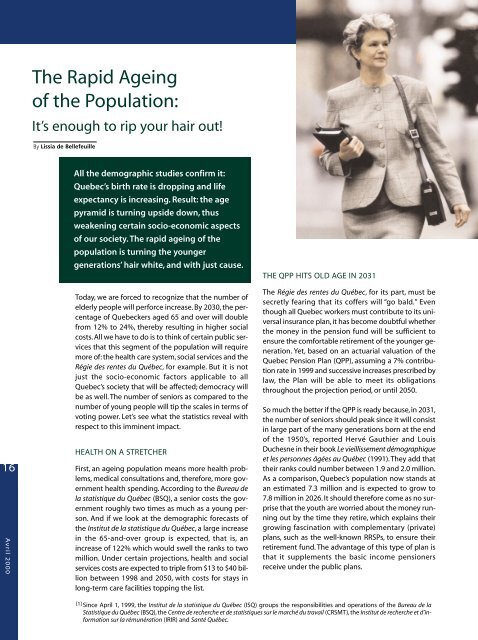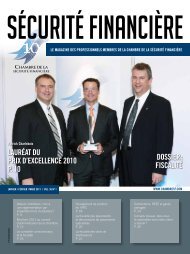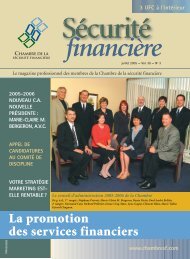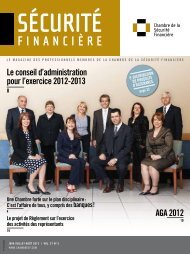avril 2000 - Chambre de la sécurité financière
avril 2000 - Chambre de la sécurité financière
avril 2000 - Chambre de la sécurité financière
Create successful ePaper yourself
Turn your PDF publications into a flip-book with our unique Google optimized e-Paper software.
The Rapid Ageingof the Popu<strong>la</strong>tion:It’s enough to rip your hair out!By Lissia <strong>de</strong> Bellefeuille16Avril <strong>2000</strong>All the <strong>de</strong>mographic studies confirm it:Quebec’s birth rate is dropping and lifeexpectancy is increasing. Result: the agepyramid is turning upsi<strong>de</strong> down, thusweakening certain socio-economic aspectsof our society. The rapid ageing of thepopu<strong>la</strong>tion is turning the youngergenerations’ hair white, and with just cause.Today, we are forced to recognize that the number ofel<strong>de</strong>rly people will perforce increase. By 2030, the percentageof Quebeckers aged 65 and over will doublefrom 12% to 24%, thereby resulting in higher socialcosts. All we have to do is to think of certain public servicesthat this segment of the popu<strong>la</strong>tion will requiremore of: the health care system, social services and theRégie <strong>de</strong>s rentes du Québec, for example. But it is notjust the socio-economic factors applicable to allQuebec’s society that will be affected; <strong>de</strong>mocracy willbe as well. The number of seniors as compared to thenumber of young people will tip the scales in terms ofvoting power. Let’s see what the statistics reveal withrespect to this imminent impact.HEALTH ON A STRETCHERFirst, an ageing popu<strong>la</strong>tion means more health problems,medical consultations and, therefore, more governmenthealth spending. According to the Bureau <strong>de</strong><strong>la</strong> statistique du Québec (BSQ), a senior costs the governmentroughly two times as much as a young person.And if we look at the <strong>de</strong>mographic forecasts ofthe Institut <strong>de</strong> <strong>la</strong> statistique du Québec, a <strong>la</strong>rge increasein the 65-and-over group is expected, that is, anincrease of 122% which would swell the ranks to twomillion. Un<strong>de</strong>r certain projections, health and socialservices costs are expected to triple from $13 to $40 billionbetween 1998 and 2050, with costs for stays inlong-term care facilities topping the list.THE QPP HITS OLD AGE IN 2031The Régie <strong>de</strong>s rentes du Québec, for its part, must besecretly fearing that its coffers will “go bald.” Eventhough all Quebec workers must contribute to its universalinsurance p<strong>la</strong>n, it has become doubtful whetherthe money in the pension fund will be sufficient toensure the comfortable retirement of the younger generation.Yet, based on an actuarial valuation of theQuebec Pension P<strong>la</strong>n (QPP), assuming a 7% contributionrate in 1999 and successive increases prescribed by<strong>la</strong>w, the P<strong>la</strong>n will be able to meet its obligationsthroughout the projection period, or until 2050.So much the better if the QPP is ready because, in 2031,the number of seniors should peak since it will consistin <strong>la</strong>rge part of the many generations born at the endof the 1950’s, reported Hervé Gauthier and LouisDuchesne in their book Le vieillissement démographiqueet les personnes âgées au Québec (1991). They add thattheir ranks could number between 1.9 and 2.0 million.As a comparison, Quebec’s popu<strong>la</strong>tion now stands atan estimated 7.3 million and is expected to grow to7.8 million in 2026. It should therefore come as no surprisethat the youth are worried about the money runningout by the time they retire, which exp<strong>la</strong>ins theirgrowing fascination with complementary (private)p<strong>la</strong>ns, such as the well-known RRSPs, to ensure theirretirement fund. The advantage of this type of p<strong>la</strong>n isthat it supplements the basic income pensionersreceive un<strong>de</strong>r the public p<strong>la</strong>ns.[1] Since April 1, 1999, the Institut <strong>de</strong> <strong>la</strong> statistique du Québec (ISQ) groups the responsibilities and operations of the Bureau <strong>de</strong> <strong>la</strong>Statistique du Québec (BSQ), the Centre <strong>de</strong> recherche et <strong>de</strong> statistiques sur le marché du travail (CRSMT), the Institut <strong>de</strong> recherche et d’informationsur <strong>la</strong> rémunération (IRIR) and Santé Québec.
















